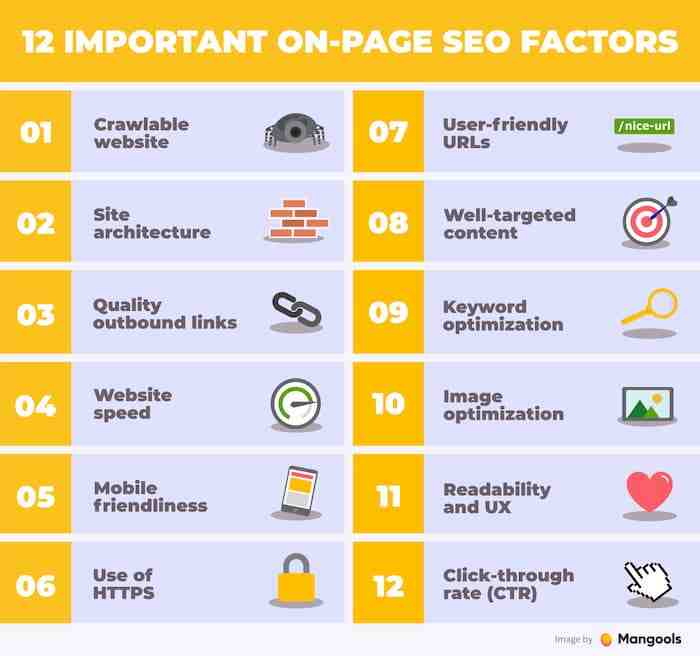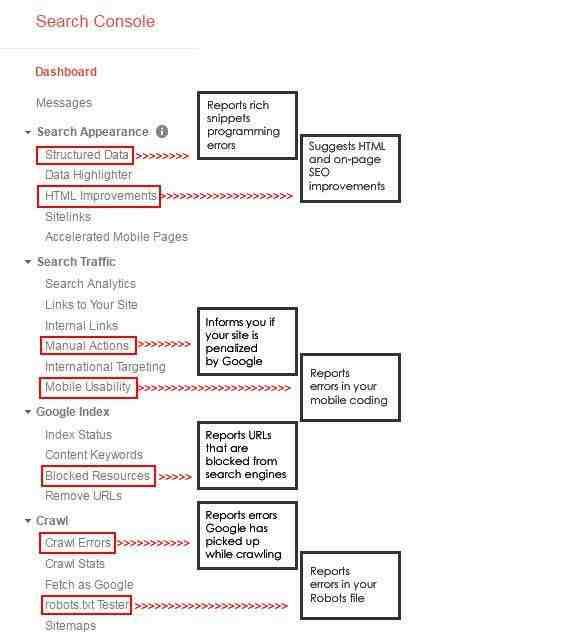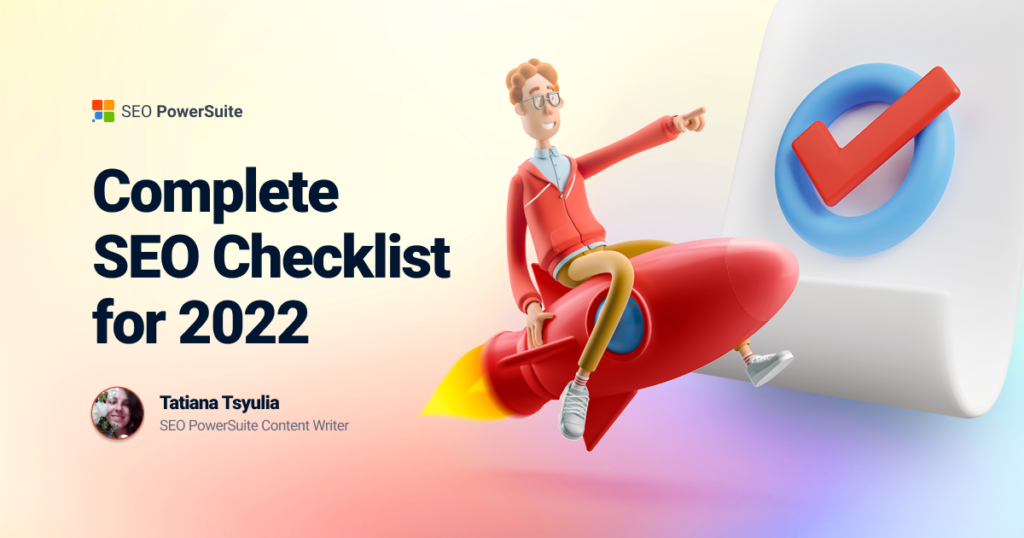Search engine optimization (SEO) is a broad discipline in which you can easily get stuck or deal with details.
Of course, specifics are important – but a top-down approach with a comprehensive strategy to keep you on track is essential.
Whether you are just starting out or you are a Fortune 500 brand, you will find that an SEO plan that takes into account a whole range of factors and constant updates will help you improve and grow.
So, in this column you will find a full checklist to help you create an SEO strategy tailored to your unique needs. You will work through key considerations for:
You need to keep in mind these factors that make up a good website. Let your content, UX, IT and other marketing resources be ready to join you on your SEO journey for the best possible results.
Technical SEO Cheat Sheet
Contents

Before you focus on the specific content you want to rank in search engines, you need to make sure that your site can be indexed and indexed.
All this falls into the category of technical SEO.
Free Reporting Platforms
Get started by making sure Google Search Console, Bing Webmaster Tools, Google Analytics, and Google Tag Manager are linked to your site.
All of these tools provide excellent diagnostic and analytical data to help you along the way.
XML Sitemap
This is a table of the content of your website. A sitemap file is a modern way of “submitting” your pages to search engines.
Most website platforms have this built-in or have plugins / add-ons that will create a dynamic sitemap that stays in sync with the pages on your site.
In the worst case, you should at least have a static one that you can generate through a number of free tools.
Robots.txt
This file provides instructions to search engines on which pages or parts of the website should not be indexed. By default, search engines will review all content they can find.
Even if you don’t want to restrict search engines from indexing any page on your site, check this file:
See best practices for setting meta robot tags & amp; Robots.txt to learn more.
Domains
If you own more than just your primary domain name, make sure you know what each of your additional domain names does. If they are parked and not in use, that’s fine.
If they redirect to your website, make sure 301 redirects to it (as opposed to page redirects or 302 redirects).
This could be a quick area to easily check and move on, but don’t ignore it as it can cause duplicate content issues and confusion about which domain name is right.
Site Architecture
The more hierarchies and structures you can incorporate into your navigation and sections of your site, the better. This will benefit users and search engines and present organized topics and content (more on that later).
Make sure your directory structure and URLs match the literal page and file structure of your website.
Stepping back and mapping the structure of your website or sitemap is a good starting point. This makes you think about content, how you prioritize certain aspects of your website, and how you want to direct your users (as well as search engines) through it.
Speed
We still see statistics showing that users spend less and less time before they bounce.
Search engines have been working for years to include page speed in their ranking factors.
Look for ways to minimize the use of JavaScript and heavy loading of code snippets on your pages, and find ways to cache or load elements externally.
There are some great tools for developers that can help you identify the right optimization areas on your own website to raise your page load time to a competitive level.
See How to Improve Website Performance: Fast 4-Speed Audit Win for More.
Mobile-Friendly
It goes without saying that we need to be adapted to mobile devices. However, even if you have built your website in a mobile framework such as responsive design, it is important to ensure that it is truly validated.
Be sure to take it through Google’s Mobile Fitness Test.
Also, perform as much user experience (UX) and quality assurance (QA) testing as possible to make sure it really works for your users on all the devices you expect them to use.
404 Pages
Don’t forget to create a custom 404 page and put useful information on it. You don’t want to lose a visitor to your site by seeing a default browser error.
You should create a 404 page that includes useful links, navigation, site search, and contact options.
SSL
Much like the need for mobile customization and site speed, it’s important to have a secure site.
If your site is not under SSL, you may lose users before they come to your site when they see a security alert in Chrome or other browsers.
Instill confidence in your website by taking the typically simple step of implementing an SSL certificate on your website.
Plugins, Add-ons, Or Extensions
If you’re using a content management system, chances are you’re already using add-ons or other code extensions you trust.
Most platforms have tools you can add to your site that provide additional control over SEO and analytics features.
Whether it’s WordPress SEO add-ons or others for Drupal, Magento, etc., you should look out for trusted add-ons, extensions, or add-ons that give you maximum control and functionality.
Core Web Vitals
Core Web Vitals is a category of additional technical factors of the site that are now important to Google.
These ranking factors are in addition to site experience factors such as mobile adaptability and page speed. These site experience factors can definitely take you through detailed coding and IT areas.
Be sure to research to learn more about CWV. If you are not the person responsible for the technical implementation of optimization updates for LCP, FID and CLS, then prepare your convincing argument as to why they are important for SEO and bring information to the team members you will rely on for the implementation.
Pre-existing Issues
Do you have baggage from the previous page or old, outdated SEO tactics?
Or, you may have a legitimate reason to have duplicate content throughout your website and web.
It is important to know what you are facing before you start optimizing your site.
If you have multiple duplicate pages, for good reason, you’ll want to consider a canonical strategy or how you want to use indexing robot instructions.
This is important to be aware of and address before you invest time and effort in site-level optimization.
Copyscape and Screaming Frog are among my favorite tools for finding duplication and analyzing content before delving into SEO on a page.
On-Page SEO Cheat Sheet

Most people tend to think about the factors on a page (e.g. keywords, content, title tags) whenever SEO is mentioned. However, the days of optimizing only individual parts of pages or websites as strategies are over.
Search engines care more about context than keywords, so don’t be tempted to just update your meta tags or body copy and move on.
The way we build context is in all the elements on the page within the page, and then we think about how the pages are interconnected within the sections and navigation of the site.
Keywords & Topics
Before you can really focus on the construction context, you need to know what you want to build it for.
If you haven’t done keyword research or wider research of your target audience, you’ll need to stop here and take some time to learn what topics and phrases your audience will use to find your website.
Remember that the days of putting an appointment in a copy of a page or bookmark are long gone.
We need to use SEO tools to discover the right terms, phrases and topics that are consistent with what we are doing. From there, we can analyze in more detail the individual words we can apply in the page architecture.
Basically, you need to know the terms that matter, map them with your content, and then start working on the rest of the list of factors on the page to follow.
Content
Content is necessary to show relevance.
If you have a few words and aspects for your website, it’s hard to compete with sites that are robust and full of content. More is not always better because high quality definitely exceeds large quantity.
But if you can achieve both, you will be in an even better place.
Rich content written for users that suits them and that is clear to search engines is what you win at. Don’t be tempted to use outdated tactics that will harm the user experience and put you at risk with search engines.
See why content is important to SEO for tips.
URL
This is the first element of the page and one that is sometimes overlooked. Search engines can index ugly, faceted URLs well.
However, a URL is an opportunity to present a clean directory structure that includes keywords and the context of what the page is about.
Don’t miss the opportunity to customize the path URL.
Title
Again, the title tag alone will not help you much. However, you must have a relevant, unique tag for each page.
Keep in mind best practices for length and keywords that are most relevant to the topic of the page, and write and implement static tags or make sure you have dynamic formulas to fill in the headline.
Meta Description
Like the title tag, we need to have a customized and thematically relevant meta description for each page.
Whether static or dynamic, make sure it’s helpful to the user, contains keywords relevant to the content, and helps build context with the title tag.
Headings
Headers or “H” tags discuss the importance for SEO. Again, I’m not focused on one element, but on how all the elements work together in building context.
If you can use title tags, do so in an organized way and make sure they use keywords that are relevant. Try to use only one H1 label and let it be the first.
Often web platforms or developers use them for CSS purposes so you may not have an H1 tag on the page and a bunch of H6 tags. Keep this in mind and the way they are woven into your code and content.
Body Copy
While much of old school focuses on latent semantic indexing, keyword density, and the formula for how many times words need to appear on an outdated page, you can’t ignore the fact that basic text on a page is often the largest block of content that can be indexed.
Don’t skip to include your focus keywords in the base copy because you need to relate to the context you’re building in other areas up to this point.
However, don’t be obsessed with using the keyword 37 times. Do what is natural and focus on the bigger picture and you will be in good shape.
Image Alt Attributes
One of the biggest red flags I get in the results of the accessibility and audit reporting tools on the page is the lack of replacement text. Alt text helps search engines understand what the image is about.
This is another opportunity to enter keywords into the page. In addition, you need to consider those in your audience who may be using a screen reader to ensure that your site is fully accessible.
Structured Data
Although not necessarily a direct ranking factor – Schema.org markup goes right to the heart of building context.
Using the right structured data tag for the content of your website can help give search engines another clue as to which segment or category your topic is in.
If your site’s platform doesn’t have an easy way to add this, and if it’s a large item in terms of cost or time, put it at the end of the line after the items listed above.
External SEO Factors

External factors are things you can’t control on your website and that don’t necessarily fall into the checklist.
However, I would be wrong to draw a picture that all you need to do is index and stuff on the page and you will climb to the top of the search engine.
Factors on the page affect the relevance and trust of your content in search engines. External factors affect your “authority” status and confirm your website as a subject matter expert.
Links
Inbound links (a.k.a. backlinks) to your website from credible and authoritative websites play a big role in SEO. Unrelated mentions of brands (aka quotes) and how much your website is talked about on the web are also important.
A lot can be said about creating great content that people naturally want to connect to.
To complement your great content, it doesn’t hurt to look for great sources of quality links through natural relationships, accreditation and possible sources of traffic in your industry.
You want to focus your efforts on quality resources that are relevant to your topic – and you never pay for a link in a way that violates relevant search engine guidelines.
Local Search
If you have a physical or service business, local directory quotes and search websites are key.
While claiming and properly owning your listing helps protect your brand at a basic level, you need to make sure that your name, address, and phone number (NAP data) are accurate and consistent on all relevant local and social sites with directories listed.
There is a whole local directory ecosystem and if you can at least deal with NAP data, you will build a good foundation.
Social media can also improve your SEO efforts (and other digital marketing), even if it won’t directly affect your rankings.
Ensuring that your website links to your own and active social media accounts and vice versa is an important first step.
In addition, you need to ensure that your level of engagement is the same as your high-ranking peers. This is a relative scale, but by understanding what your competition is doing you can ensure that the SEO aspect of social media is covered.
Conclusion

I hope this checklist will help you optimize your website. Improving the technical and SEO optimization of your website will help Google find and index your content.
As you continue to optimize your website, track your organic search traffic in Google Analytics to see the results of your changes.
Featured image: E.F.S / Shutterstock
What are the 3 components of SEO?

We have covered three basic parts of SEO: technical SEO, SEO content / relevance and SEO promotion / authority.
What are the 3 types of SEO? Three types of SEO are:
- SEO on the page â € “Everything on your website â €“ Blogs, product copies, web copies.
- SEO out of page – everything that happens outside of your website that helps in your SEO strategy – backlinks.
- Technical SEO – everything that is technically taken to improve search rankings – site indexing to help crawl indexing.
What is SEO example?
Companies are looking for search engine optimization, or SEO, to gain more awareness and to raise their company to search engine rankings. SEO is used through search engines such as Google, Yahoo, MSN, Bing, etc. Search engine optimization uses keywords that attract users to the company.
What is SEO on a website? Search engine optimization (SEO) often refers to small modifications to parts of your website. … One of those users is the browser, which helps other users discover your content. SEO is helping search engines understand and present content.
What is SEO in simple words?
SEO stands for Search Engine Optimization, a set of practices designed to improve the appearance and positioning of websites in organic search results.
How does SEO work in simple words?
SEO works by optimizing website pages, conducting keyword research and earning inbound links. In general, you can see the results of SEO efforts after a website is indexed and indexed by a search engine.
What is SEO and how it works?
Well, SEO stands for ‘Search Engine Optimization’, which is the process of getting traffic from free, organic, editorial or natural search engine results. It aims to improve the position of your website on search results pages. Remember, the higher a website is, the more people will see it.
Which is example of on-page SEO?
Examples of some SEO actions on a page include: Optimizing your title tags and meta descriptions. Writing detailed, quality content. Clean up the code of your website.
What is on page in SEO?
On-page SEO (search engine optimization) refers to the process of optimizing pages on your site to improve rankings and user experience. This is the opposite of off-site SEO, which is about optimizing for elements outside of your website. This may include feedback or mentioning social media.
Which is the most important on page SEO factor?
Meta tags are the most important factor of On Page SEO. It has four basic components: Meta Title, Meta Description, Meta Keywords and Meta Robots Tag.
What is the most important SEO ranking factor related to page content *? Content is one of the most important factors in SEO ranking. Search engines want to provide the best possible results by giving top rankings to sites that have well-researched, in-depth and well-designed content.
What are the important aspects of on page SEO?
In addition to publishing relevant, high-quality content, SEO on the site includes optimizing your titles, HTML tags (title, meta and header) and images. It also means that your website has a high level of expertise, authority and reliability.
Which of the following is an aspect of on page SEO?
SEO on a page refers to the SEO elements you control on a website or by the website itself. Examples of SEO on a page include content, titles and headers, image optimization, title tags, meta descriptions, structured data, and more.
What are the 3 most important on page SEO factors?
To conclude, the most important SEO factors on a page include well-written and original content, a good title and description tag, formatting with proper use of titles and subtitles, use of images and their descriptions, and well-composed URLs. which contain the most important keyword and are not too long.
What are the 3 most important on page SEO factors?
To conclude, the most important SEO factors on a page include well-written and original content, a good title and description tag, formatting with proper use of titles and subtitles, use of images and their descriptions, and well-composed URLs. which contain the most important keyword and are not too long.
What are 3 main areas of SEO?
There are three types of SEO you need for a well-rounded organic search strategy: on-site SEO, technical SEO and off-site SEO. By breaking down your strategy and thinking about SEO as these three categories, it will be much easier to organize and execute your optimization plans.
What are the 4 main components of an SEO?
The stronger the links between each of the 4 SEO components – technical SEO, on-page SEO, off-site SEO and content – the better the results. Awareness of relationships will help us better understand how to make the most of them.
What are the main components of SEO? The three main types of SEO factors on a page are content, architecture, and HTML.



